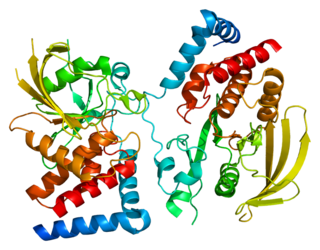
RNA-binding protein 8A is a protein that in humans is encoded by the RBM8A gene.

Ovarian cancer G-protein coupled receptor 1 is a protein that in humans is encoded by the GPR68 gene.

Cyclin-dependent kinase 4 inhibitor B also known as multiple tumor suppressor 2 (MTS-2) or p15INK4b is a protein that is encoded by the CDKN2B gene in humans.

Suppressor of tumorigenicity 14 protein, also known as matriptase, is a protein that in humans is encoded by the ST14 gene. ST14 orthologs have been identified in most mammals for which complete genome data are available.

Eukaryotic elongation factor 2 is a protein that in humans is encoded by the EEF2 gene. It is the archaeal and eukaryotic counterpart of bacterial EF-G.

Deleted in Liver Cancer 1 also known as DLC1 and StAR-related lipid transfer protein 12 (STARD12) is a protein which in humans is encoded by the DLC1 gene.

RNA-binding motif 10 is a protein that is encoded by the RBM10 gene. This gene maps on the X chromosome at Xp11.23 in humans. RBM10 is a regulator of alternative splicing. Alternative splicing is a process associated with gene expression to produce multiple protein isoforms from a single gene, thereby creating functional diversity and cellular complexity. RBM10 influences the expression of many genes, participating in various cellular processes and pathways such as cell proliferation and apoptosis. Its mutations are associated with various human diseases such as TARP syndrome, an X-linked congenital disorder in males resulting in pre‐ or postnatal lethality, and various cancers in adults.

Large tumor suppressor kinase 1 (LATS1) is an enzyme that in humans is encoded by the LATS1 gene.

RNA-binding protein 5 is a protein that in humans is encoded by the RBM5 gene.

Nucleus accumbens-associated protein 1 is a protein that in humans is encoded by the NACC1 gene.

Sodium-coupled neutral amino acid transporter 3 is a protein that in humans is encoded by the SLC38A3 gene.

Opioid-binding protein/cell adhesion molecule is a protein that in humans is encoded by the OPCML gene.

Dynein light chain roadblock-type 1 is a protein that in humans is encoded by the DYNLRB1 gene.

Receptor-type tyrosine-protein phosphatase gamma is an enzyme that in humans is encoded by the PTPRG gene.

Diphthine synthase is an enzyme that in humans is encoded by the DPH5 gene.

Tumor suppressor candidate 3 is a protein that in humans is encoded by the TUSC3 gene.

RNA-binding protein 6 is a protein that in humans is encoded by the RBM6 gene. RBM6 orthologs have been identified in all mammals for which complete genome data are available.

Nucleosome assembly protein 1-like 4 is a protein that in humans is encoded by the NAP1L4 gene.

Myosin-XVIIIb is a protein that in humans is encoded by the MYO18B gene.

Tumor suppressor candidate 2 is a protein that in humans is encoded by the TUSC2 gene.

















